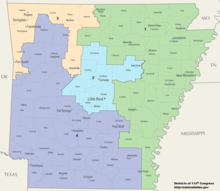Baker v. Carr, 369 U.S. 186 (1962), was a landmark United States Supreme Court case in which the Court held that redistricting qualifies as a justiciable question under the Fourteenth Amendment, thus enabling federal courts to hear Fourteenth Amendment-based redistricting cases. The court summarized its Baker holding in a later decision as follows: "Equal Protection Clause of the Fourteenth Amendment limits the authority of a State Legislature in designing the geographical districts from which representatives are chosen either for the State Legislature or for the Federal House of Representatives.". The court had previously held in Gomillion v. Lightfoot that districting claims over racial discrimination could be brought under the Fifteenth Amendment.

The Virginia General Assembly is the legislative body of the Commonwealth of Virginia, the oldest continuous law-making body in the Western Hemisphere, the first elected legislative assembly in the New World, and was established on July 30, 1619. The General Assembly is a bicameral body consisting of a lower house, the Virginia House of Delegates, with 100 members, and an upper house, the Senate of Virginia, with 40 members. Combined, the General Assembly consists of 140 elected representatives from an equal number of constituent districts across the commonwealth. The House of Delegates is presided over by the Speaker of the House, while the Senate is presided over by the Lieutenant Governor of Virginia. The House and Senate each elect a clerk and sergeant-at-arms. The Senate of Virginia's clerk is known as the "Clerk of the Senate".

United States congressional apportionment is the process by which seats in the United States House of Representatives are distributed among the 50 states according to the most recent decennial census mandated by the United States Constitution. Each state is apportioned a number of seats which approximately corresponds to its share of the aggregate population of the 50 states. Every state is constitutionally guaranteed at least one seat in the House and two seats in the Senate, regardless of population.
Redistricting in the United States is the process of drawing electoral district boundaries. For the United States House of Representatives, and state legislatures, redistricting occurs after each decennial census.
Congressional districts, also known as electoral districts and legislative districts, electorates, or wards in other nations, are divisions of a larger administrative region that represent the population of a region in the larger congressional body. Notably, Australia's districts are referred to as electorates or seats; in Canada, these are called "constituencies", or more informally "ridings". Countries with congressional districts include the United States, the Philippines, and Japan.
The Constitution of Arkansas is the primary organizing law for the U.S. state of Arkansas delineating the duties, powers, structures, and functions of the state government. Arkansas' original constitution was adopted at a constitutional convention held at Little Rock in advance of the territory's admission to the Union in 1836. The current constitution was ratified in 1874 following the Brooks–Baxter War.

Ohio is divided into 16 congressional districts, each represented by a member of the United States House of Representatives. After the 2010 Census, Ohio lost two House seats due to slow population growth compared to the national average, and a new map was signed into law on September 26, 2011. This map was ruled unconstitutional as partisan gerrymandering, and state Republicans were told to redraw the map before June 14, 2019. However, on October 7, 2019, the U.S. Supreme Court dismissed the challenge to the map, allowing it to stay in effect for the 2020 election.
The redistricting of United States congressional districts is made by the legislatures of the states every 10 years, immediately following the official announcement of the federal census that serves as the basis of the apportionment. It was long the practice that the apportionment thus made stood until after the next decennial census.

Virginia is currently divided into 11 congressional districts, each represented by a member of the United States House of Representatives. The districts were redrawn most recently in 2016 by court order.
Texas has had at-large congressional seats at various times in its history. It was often the case when the state received new congressional seats as a result of reapportionment, that it would have a representative elected from an at-large seat, voted on by all voters in the state. This enabled the legislature, which was dominated by legislators from rural districts, to postpone re-districting that would reduce their power by apportioning districts to recognize the increased population and economic power of the developing major cities.

In the United States, a redistricting commission is a body, other than the usual state legislative bodies, established to draw electoral district boundaries. Generally the intent is to avoid gerrymandering, or at least the appearance of gerrymandering, by specifying a nonpartisan or bipartisan body to comprise the commission drawing district boundaries.
Redistribution is the process by which electoral districts are added, removed, or otherwise changed. Redistribution is a form of boundary delimitation that changes electoral district boundaries, usually in response to periodic census results. Redistribution is required by law or constitution at least every decade in most representative democracy systems that use first-past-the-post or similar electoral systems to prevent geographic malapportionment. The act of manipulation of electoral districts to favour a candidate or party is called gerrymandering.

Redistricting in Pennsylvania refers to the decennial process of redrawing state legislative and federal congressional districts in Pennsylvania.

The U.S. state of Arizona, in common with the other U.S. states, must redraw its congressional and legislative districts every ten years to reflect changes in the state and national populations. Redistricting normally follows the completion of the United States census, which is carried out by the federal government the first year of every decade; the most recent census took place in 2020. Historically, Arizona's legislature had control over the redistricting process. However, Proposition 106, passed in 2000, delegated the power to draw congressional and legislative boundaries to a bipartisan independent commission. The Arizona Independent Redistricting Commission (AIRC) comprises two Democrats, two Republicans, and one independent chair. County and local redistricting, which normally takes place along the same timeline as congressional and legislative redistricting, is carried out by the individual county and local governments rather than the AIRC.
The State government of Arkansas is divided into three branches: executive, legislative and judicial. These consist of the state governor's office, a bicameral state legislature known as the Arkansas General Assembly, and a state court system. The Arkansas Constitution delineates the structure and function of the state government. Since 1963, Arkansas has had four seats in the U.S. House of Representatives. Like all other states, it has two seats in the U.S. Senate.

The 2020 United States redistricting cycle is in progress following the completion of the 2020 United States census. In all fifty states, various bodies are re-drawing state legislative districts. States that are apportioned more than one seat in the United States House of Representatives are also drawing new districts for that legislative body.

Redistricting in Virginia has been a controversial topic due to allegations of gerrymandering. In the 2017 Virginia General Assembly, all of the redistricting reform bills were killed.

Redistricting in North Carolina has been a controversial topic due to allegations and admissions of gerrymandering.

Redistricting in Wisconsin is the process by which boundaries are redrawn for municipal wards, Wisconsin State Assembly districts, Wisconsin State Senate districts, and Wisconsin's congressional districts. Redistricting occurs—as in other U.S. states—once every decade, usually in the year after the decennial United States census. According to the Wisconsin Constitution, redistricting in Wisconsin follows the regular legislative process, it must be passed by both houses of the Wisconsin Legislature and signed by the Governor of Wisconsin—unless the Legislature has sufficient votes to override a gubernatorial veto. Due to legislative gridlock, however, it has become common for Wisconsin redistricting to be conducted by courts. The 1982, 1992, and 2002 legislative maps were each created by panels of United States federal judges.
Smiley v. Holm, 285 U.S. 355 (1932), was a decision of the Supreme Court of the United States involving a governor's power to veto a congressional redistricting proposal passed by a state's legislature. In an opinion by Chief Justice Charles Evans Hughes, the Court unanimously held that the U.S. Constitution did not prohibit Minnesota's governor from vetoing that state's redistricting map.










